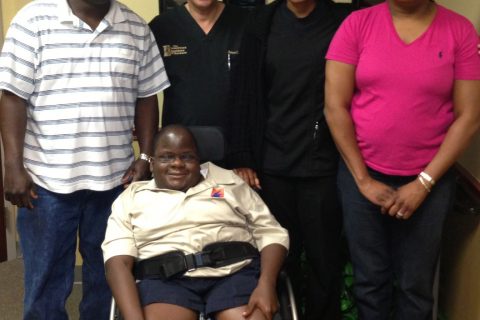
VIDEO: HC-BPPV in 16 year old male with Spina bifida
Published on: April 30, 2013
 A 16 year-old male with a severe form of Spina bifida (lower body paralysis, AV shunt, and thoracic cavity) was referred to AIB by a pediatric otolaryngologist for evaluation of positional vertigo. There was no precedent otologic or acute onset episode, nor any auditory complaints. The provoked vertigo lasts only seconds, without any other associated focal neurologic or otologic symptoms. He had been seen at the ER due to concerns of co-morbidities associated with the S.B. and subsequently referred to ENT. Initially the primary position which provoked the symptoms were when lying on his back, but had recently changed to much stronger vertigo when on his side. It now seems as if it occurs on both sides. The transient but acute symptoms are very disturbing based on the patient’s already limited and restricted mobility.
A 16 year-old male with a severe form of Spina bifida (lower body paralysis, AV shunt, and thoracic cavity) was referred to AIB by a pediatric otolaryngologist for evaluation of positional vertigo. There was no precedent otologic or acute onset episode, nor any auditory complaints. The provoked vertigo lasts only seconds, without any other associated focal neurologic or otologic symptoms. He had been seen at the ER due to concerns of co-morbidities associated with the S.B. and subsequently referred to ENT. Initially the primary position which provoked the symptoms were when lying on his back, but had recently changed to much stronger vertigo when on his side. It now seems as if it occurs on both sides. The transient but acute symptoms are very disturbing based on the patient’s already limited and restricted mobility.
As I have written in prior posts, articles and chapters the biomechanics of Canalith Repositioning is important for patient comfort, safety and isolation of ear and canal. For those special needs individuals who have even greater restricted mobility, it is critically important for the successful treatment outcome. I performed his evaluation and subsequent treatment on a low-rise mat table:
• Modified Hallpike were negative for PC-BPPV of either ear – used a side lying technique (similar to position #1 of Gans or Semont repositioning maneuvers). Apparently he had self-migrated to the HC, which explains the change in symptoms and the seemingly bilateral response.
• Positive left ear HC-BPPV – see video
• Treatment left ear – Casani – see video
• Re-check right ear – Negative, treated with an Appiani (left ear) prophylactically – see video
• Patient is then allowed to check for symptoms immediately following treatment with similar sleeping conditions- lying back, elevated on wedge.